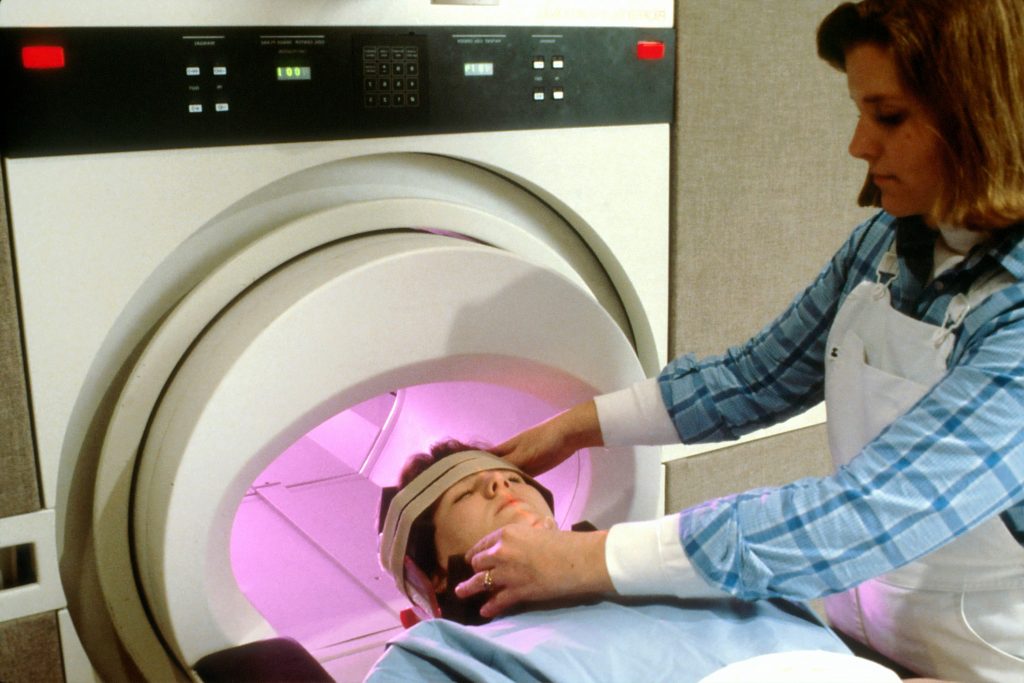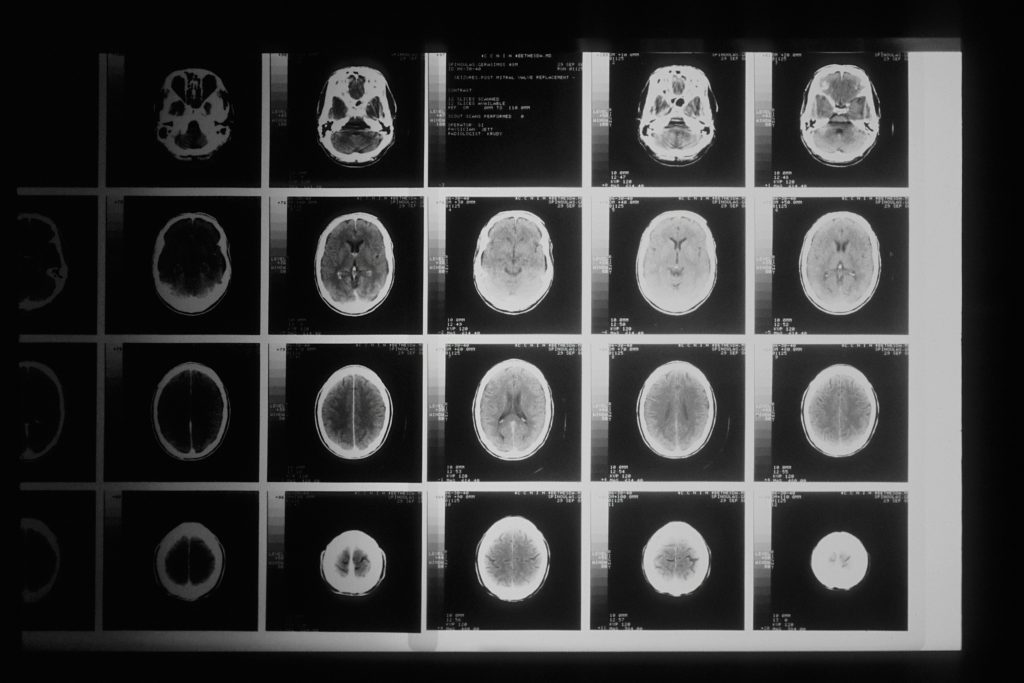
Bipolar dysfunction (BD) is a severe psychological sickness with important hereditary elements and predominantly affecting youthful populations (O’Connell et al., 2022). Presently, prognosis is primarily finished through medical interview. Nevertheless, diagnosing BD, particularly in adolescents, is difficult as a result of ambiguity of subthreshold signs, as mentioned in earlier blogs: Is it bipolar dysfunction or borderline persona dysfunction? and Bettering prognosis of bipolar dysfunction.
This results in lengthy gaps between first signs and formal prognosis, which for many individuals may be a few years, thereby enormously delaying the beginning of remedy and care. The length of untreated bipolar dysfunction is thought to have a powerful adverse impression on long-term outcomes, notably with excessive danger of suicidality (Di Salvo et al., 2023).
Whereas magnetic resonance imaging (MRI) just isn’t standardly used for prognosis, researchers use imaging to discover the results of bipolar dysfunction on the mind (Strakowski et al., 2005). Nevertheless, conventional analysis relied totally on single-modality MRI, which can not absolutely seize the advanced interaction of genetic and environmental components influencing BD (Waller et al., 2021). New approaches that harness imaging applied sciences, together with multimodal MRIs blended with machine studying (ML) (Campos-Ugaz et al., 2023), have the potential to scale back the diagnostic hole and result in earlier interventions.
Within the present research, Wu and colleagues aimed to enhance bipolar dysfunction diagnostic accuracy by integrating multimodal MRI information with behavioural measures. Utilizing ML strategies, the authors developed and evaluated three diagnostic fashions throughout neuropsychiatric teams, together with offspring of BD sufferers with (OBDs) and with out subthreshold signs (OBDns), non-BD offspring with subthreshold signs (nOBDs), BD sufferers, and wholesome controls (HC). The general intention of this research was to boost early identification and intervention methods by combining conventional medical metrics with superior neuroimaging and ML approaches.

Wu and colleagues (2024) developed three multinomial bipolar dysfunction classification fashions: a medical prognosis mannequin utilizing behavioural variables, a data-driven mannequin specializing in MRI-features and a complete mannequin integrating behaviour and anatomical and practical options.
Strategies
Two datasets have been used on this research: a main dataset for mannequin development and validation, sourced from the Recognition and Early Intervention of Prodromal Bipolar Issues initiative (Lin et al., 2015), consisting of 309 members (excluding sufferers over 20 years outdated) and an age-matched impartial exterior validation dataset from Nanjing Mind Hospital, comprising 40 BD sufferers and 34 wholesome controls. To gather behavioural measures, members underwent systematic medical evaluations utilizing numerous scales to evaluate signs like anxiousness, melancholy, mania, and psychotic signs. Familial historical past was validated, and world performance was assessed.
Three varieties of MRI information modalities have been acquired utilizing a 3.0 Tesla scanner: T1-weighted photos, diffusions tensor imaging (DTI), and resting-state practical MRI. The mind was divided into 400 totally different areas utilizing the Schaefer 400 parcellation. Structural measures (quantity, thickness, floor space), structural connectivity (fractional anisotropy, imply diffusivity) and practical connectivity measures have been computed for every mind space. Normal pre-processing steps, together with correcting for movement within the scanner, denoising, and normalizing the information have been adopted.
Three classification fashions have been constructed: a medical prognosis mannequin focussing on behavioural attributes; an MRI-based mannequin focussing on morphometric and practical and structural connectivity measures; and a complete mannequin integrating imaging and behavioural options. The fashions categorized the topics into 5 teams (OBDs, OBDns, nOBDS, BD, HC), divided right into a coaching and a testing set, with an 80:20 ratio.
Outcomes
The 5 teams have been comparable in age, training, and gender distribution. Nevertheless, important variations have been noticed in medical measures and world functioning. Parental historical past of psychiatric circumstances, particularly bipolar dysfunction, additionally various considerably, notably amongst offspring of people with BD.
Total, 6006 MRI-derived metrics and 16 behavioural variables have been used for the classification evaluation. The three fashions have been used for multinomial classification and to determine essential options.
- Scientific prognosis mannequin: This mannequin used solely behavioural variables (scales assessing anxiousness, melancholy, mania, psychotic signs and world functioning) and household historical past to categorise the members. It achieved a coaching accuracy of 0.78 and a take a look at accuracy of 0.75, with an general predictive accuracy of 0.75 (starting from 0.62 to 0.85). The mannequin’s discriminative skill between the teams was robust.
- MRI-based mannequin: This mannequin used solely MRI metrics (morphometric and graph measures) to evaluate the distinctive predictive energy of anatomical and community options. It reached a coaching accuracy of 0.63 and a predictive accuracy of 0.65 (starting from 0.52 to 0.77). The discriminative skill was additionally notable, particularly for BD and HC teams, although barely decrease than the medical mannequin.
- Complete mannequin: Lastly, this mannequin built-in each MRI and behavioural options, yielding the best efficiency with a coaching accuracy of 0.83 and an general accuracy of 0.83 (starting from 0.72 to 0.92). The mannequin confirmed superior discriminative skill throughout all teams. The great mannequin was validated utilizing an impartial exterior dataset to differentiate BD sufferers from HC, attaining excessive accuracy (89.19%). Sensitivity and specificity metrics have been additionally excessive, confirming the mannequin’s robustness in distinguishing BD from HC.
The great mannequin was discovered to be probably the most dependable, as confirmed by systematic cross-validation. It considerably outperformed the MRI-based and medical fashions. By way of characteristic significance, each behavioural and MRI-derived metrics have been essential for correct classification. Key discriminative options included parental BD historical past, and world perform (through World Evaluation Scale). A number of morphometric and connectivity measures, together with particular mind areas volumes and imply diffusivity have been additionally necessary. A structural equation mannequin additional explored the relationships amongst psychiatric signs, mind well being derived from 20 MRI metrics, medical prognosis, and parental BD historical past. The mannequin demonstrated a average to acceptable match, highlighting the advanced interaction between these components.

Utilizing MRI-based metrics and behavioural measures, Wu and colleagues demonstrated the accuracy of utilizing a complete mannequin to categorise bipolar dysfunction sufferers, offspring, and wholesome controls.
Conclusions
In conclusion, Wu and colleagues demonstrated the efficacy of integrating multimodal MRI metrics with behavioural evaluation measures to attain larger diagnostic accuracy of bipolar dysfunction in adolescents.
Future exploration of incorporating advance imaging into medical observe are wanted to evaluate the implication for enhancing affected person outcomes in psychiatry.

Wu and colleague encourage additional exploration into incorporating superior imaging into medical observe in psychiatry to enhance affected person outcomes.
Strengths and limitations
A number of strengths and limitations of this research are of observe. First, combining behavioural assessments, together with parental historical past of psychological sickness, with MRI metrics presents a holistic view of neuropsychiatric circumstances, which permits for detection of mind abnormalities that might go unnoticed via behavioural information alone. Furthermore, by specializing in the diagnostic course of in a real-world setting, Wu and colleagues tackle the sensible challenges of diagnosing bipolar dysfunction in adolescents and hinting on the potential utility of MRI for medical observe.
Moreover, along with emphasizing the function of familial historical past of psychological sickness and world functioning, the research highlights particular mind areas and behavioural measures which can be notably discriminative within the prognosis of bipolar dysfunction, highlighting parameters that ought to be rigorously monitored. Lastly, by testing the fashions on an exterior dataset, the authors made efforts to enhance the generalizability of the findings, which helps the potential adoption of this strategy in broader medical observe.
Nevertheless, just a few limitations must be talked about. First, the pattern dimension inside every group was comparatively small, which limits the generalizability of the findings and the statistical energy of the fashions. A bigger pattern dimension would improve the robustness and reliability of the findings. As well as, as a result of complexity of adolescent growth and the cohort within the research being derived from a particular inhabitants, the pattern on this research could not characterize the complete variety of adolescence, limiting applicability throughout totally different ethnic, socio-economic and environmental backgrounds.
Importantly, the research is retrospective, which can introduce choice bias and it relied on the basic assumption that the preliminary medical diagnoses have been correct. A potential long-term longitudinal research would decide the accuracy of the fashions to foretell future outcomes and the potential utility of this device in routine medical observe.

The research emphasizes the function of familial historical past of psychological diseases and world functioning for the prognosis of bipolar dysfunction in adolescents.
Implications for observe
Total, the paper presents a promising framework for integrating MRI metrics and behavioural information to enhance BD prognosis in adolescents. Nevertheless, limitations associated to pattern dimension, generalizability, and diagnostic assumptions spotlight areas the place future analysis may develop and refine the strategy. The findings from this research have a number of implications for observe:
Improved early prognosis and personalised interventions
- The combination of MRI metrics with behavioural assessments may need the potential to allow earlier and extra correct diagnoses of bipolar dysfunction in adolescents, notably for these with a excessive genetic danger, by lowering ambiguity between overlapping signs, and to tailor remedy plans primarily based on a person’s neuroimaging profile and behavioural historical past.
- This might result in earlier interventions, doubtlessly mitigating the severity or development of the dysfunction and enhancing long-term outcomes.
Enhanced danger stratification
- For adolescents with subthreshold signs, this multimodal strategy could enhance clinicians’ skill to stratify danger.
- Behavioural information, together with psychiatric familial historical past and functioning ranges, mixed with MRI information, could assist determine these at increased danger for growing BD, even earlier than clear neuroimaging abnormalities manifest.
Incorporation into medical workflows
- The success of integrating MRI and behavioural information may result in the routine use of neuroimaging in medical observe, notably for difficult-to-diagnose circumstances.
- This may increasingly improve reliance on MRI applied sciences as a diagnostic device in psychological well being settings, although value and accessibility issues should be addressed.
Potential for broader use of multimodal fashions
- The demonstrated efficacy of this strategy for BD could encourage comparable multimodal diagnostic fashions for different neuropsychiatric circumstances, similar to schizophrenia, main depressive dysfunction, or anxiousness issues.
- Increasing this mannequin may enhance diagnostic precision throughout a variety of psychological well being circumstances.
Whereas MRI may show helpful in medical observe, just a few issues for implementation ought to be thought-about. First, incorporating MRI into routine diagnostic observe would require investments in expertise, workers coaching, and reimbursement fashions, as MRI is expensive and never universally accessible. As well as, clinicians could require further coaching to interpret neuroimaging information alongside behavioural assessments, in addition to to know the implications of integrating such findings into prognosis and remedy.
It is usually necessary to notice that whereas MRI expertise has been used for many years for analysis and in some medical frameworks, present process a scan just isn’t a trivial expertise and might result in discomfort or misery in some circumstances. Thus, it is probably not really helpful for some populations. Lastly, though on this research, MRI improves diagnostic precision, will probably be necessary for healthcare techniques to weigh the numerous value of neuroimaging towards its advantages, particularly in resource-limited settings and its use would possibly, for instance, be restricted to high-risk people.
Total, utilising MRI information and behavioural measures for the prognosis of bipolar issues in adolescents has the potential to enhance prognosis and long-term outcomes of sufferers and at-risk people, though some severe issues for medical implementations should be examined.

The research emphasises the potential of adopting a multimodal strategy, incorporating imaging and behavioural information, to enhance prognosis of bipolar dysfunction in adolescence.
Assertion of pursuits
No battle of pursuits to declare.
Hyperlinks
Major paper
Wu J., Lin Ok., Lu W., Zou W., Li X., Tan Y., Yang J., Zheng D., Liu X., Lam B.Y.-H., Xu G., Wang Ok., McIntyre R.S., Wang F., So Ok.-F. & Wang J. Enhancing Early Prognosis of Bipolar Dysfunction in Adolescents via Multimodal Neuroimaging Organic Psychiatry (2024), doi: https://doi.org/10.1016/j.biopsych.2024.07.018
Different references
Campos-Ugaz WA, Palacios Garay JP, Rivera-Lozada O, Alarcón Diaz MA, Fuster-Guillén D, Tejada Arana AA. An Overview of Bipolar Dysfunction Prognosis Utilizing Machine Studying Approaches: Scientific Alternatives and Challenges. Iran J Psychiatry 18(2):237-247 (2023). https://doi.org/10.18502/ijps.v18i2.12372
Di Salvo, G., Porceddu, G., Albert, U. et al. Correlates of lengthy length of untreated sickness (DUI) in sufferers with bipolar dysfunction: outcomes of an observational research. Ann Gen Psychiatry 22, 12 (2023). https://doi.org/10.1186/s12991-023-00442-5
Lin, Ok., Xu, G., Wong, N. M. L., Wu, H., Li, T., Lu, W., . . . Lee, T. M. C. A Multi-Dimensional and Integrative Strategy to Analyzing the Excessive-Threat and Extremely-Excessive-Threat Levels of Bipolar Dysfunction. eBioMedicine, 2(8), 919-928 (2015). https://doi.org/10.1016/j.ebiom.2015.06.027
O’Connell, Ok. S., Smeland, O. B., & Andreassen, O. A. Chapter 3 – Genetics of bipolar dysfunction. In E. E. Tsermpini, M. Alda, & G. P. Patrinos (Eds.), Psychiatric Genomics (pp. 43-61): Educational Press (2022). https://doi.org/10.1016/B978-0-12-819602-1.00003-6
Strakowski, S., DelBello, M. & Adler, C. The practical neuroanatomy of bipolar dysfunction: a assessment of neuroimaging findings. Mol Psychiatry 10, 105–116 (2005). https://doi.org/10.1038/sj.mp.4001585
Waller, J., Miao, T., Ikedionwu, I. et al. Reviewing purposes of structural and practical MRI for bipolar dysfunction. Jpn J Radiol 39, 414–423 (2021). https://doi.org/10.1007/s11604-020-01074-5
Photograph credit

Bipolar dysfunction (BD) is a severe psychological sickness with important hereditary elements and predominantly affecting youthful populations (O’Connell et al., 2022). Presently, prognosis is primarily finished through medical interview. Nevertheless, diagnosing BD, particularly in adolescents, is difficult as a result of ambiguity of subthreshold signs, as mentioned in earlier blogs: Is it bipolar dysfunction or borderline persona dysfunction? and Bettering prognosis of bipolar dysfunction.
This results in lengthy gaps between first signs and formal prognosis, which for many individuals may be a few years, thereby enormously delaying the beginning of remedy and care. The length of untreated bipolar dysfunction is thought to have a powerful adverse impression on long-term outcomes, notably with excessive danger of suicidality (Di Salvo et al., 2023).
Whereas magnetic resonance imaging (MRI) just isn’t standardly used for prognosis, researchers use imaging to discover the results of bipolar dysfunction on the mind (Strakowski et al., 2005). Nevertheless, conventional analysis relied totally on single-modality MRI, which can not absolutely seize the advanced interaction of genetic and environmental components influencing BD (Waller et al., 2021). New approaches that harness imaging applied sciences, together with multimodal MRIs blended with machine studying (ML) (Campos-Ugaz et al., 2023), have the potential to scale back the diagnostic hole and result in earlier interventions.
Within the present research, Wu and colleagues aimed to enhance bipolar dysfunction diagnostic accuracy by integrating multimodal MRI information with behavioural measures. Utilizing ML strategies, the authors developed and evaluated three diagnostic fashions throughout neuropsychiatric teams, together with offspring of BD sufferers with (OBDs) and with out subthreshold signs (OBDns), non-BD offspring with subthreshold signs (nOBDs), BD sufferers, and wholesome controls (HC). The general intention of this research was to boost early identification and intervention methods by combining conventional medical metrics with superior neuroimaging and ML approaches.

Wu and colleagues (2024) developed three multinomial bipolar dysfunction classification fashions: a medical prognosis mannequin utilizing behavioural variables, a data-driven mannequin specializing in MRI-features and a complete mannequin integrating behaviour and anatomical and practical options.
Strategies
Two datasets have been used on this research: a main dataset for mannequin development and validation, sourced from the Recognition and Early Intervention of Prodromal Bipolar Issues initiative (Lin et al., 2015), consisting of 309 members (excluding sufferers over 20 years outdated) and an age-matched impartial exterior validation dataset from Nanjing Mind Hospital, comprising 40 BD sufferers and 34 wholesome controls. To gather behavioural measures, members underwent systematic medical evaluations utilizing numerous scales to evaluate signs like anxiousness, melancholy, mania, and psychotic signs. Familial historical past was validated, and world performance was assessed.
Three varieties of MRI information modalities have been acquired utilizing a 3.0 Tesla scanner: T1-weighted photos, diffusions tensor imaging (DTI), and resting-state practical MRI. The mind was divided into 400 totally different areas utilizing the Schaefer 400 parcellation. Structural measures (quantity, thickness, floor space), structural connectivity (fractional anisotropy, imply diffusivity) and practical connectivity measures have been computed for every mind space. Normal pre-processing steps, together with correcting for movement within the scanner, denoising, and normalizing the information have been adopted.
Three classification fashions have been constructed: a medical prognosis mannequin focussing on behavioural attributes; an MRI-based mannequin focussing on morphometric and practical and structural connectivity measures; and a complete mannequin integrating imaging and behavioural options. The fashions categorized the topics into 5 teams (OBDs, OBDns, nOBDS, BD, HC), divided right into a coaching and a testing set, with an 80:20 ratio.
Outcomes
The 5 teams have been comparable in age, training, and gender distribution. Nevertheless, important variations have been noticed in medical measures and world functioning. Parental historical past of psychiatric circumstances, particularly bipolar dysfunction, additionally various considerably, notably amongst offspring of people with BD.
Total, 6006 MRI-derived metrics and 16 behavioural variables have been used for the classification evaluation. The three fashions have been used for multinomial classification and to determine essential options.
- Scientific prognosis mannequin: This mannequin used solely behavioural variables (scales assessing anxiousness, melancholy, mania, psychotic signs and world functioning) and household historical past to categorise the members. It achieved a coaching accuracy of 0.78 and a take a look at accuracy of 0.75, with an general predictive accuracy of 0.75 (starting from 0.62 to 0.85). The mannequin’s discriminative skill between the teams was robust.
- MRI-based mannequin: This mannequin used solely MRI metrics (morphometric and graph measures) to evaluate the distinctive predictive energy of anatomical and community options. It reached a coaching accuracy of 0.63 and a predictive accuracy of 0.65 (starting from 0.52 to 0.77). The discriminative skill was additionally notable, particularly for BD and HC teams, although barely decrease than the medical mannequin.
- Complete mannequin: Lastly, this mannequin built-in each MRI and behavioural options, yielding the best efficiency with a coaching accuracy of 0.83 and an general accuracy of 0.83 (starting from 0.72 to 0.92). The mannequin confirmed superior discriminative skill throughout all teams. The great mannequin was validated utilizing an impartial exterior dataset to differentiate BD sufferers from HC, attaining excessive accuracy (89.19%). Sensitivity and specificity metrics have been additionally excessive, confirming the mannequin’s robustness in distinguishing BD from HC.
The great mannequin was discovered to be probably the most dependable, as confirmed by systematic cross-validation. It considerably outperformed the MRI-based and medical fashions. By way of characteristic significance, each behavioural and MRI-derived metrics have been essential for correct classification. Key discriminative options included parental BD historical past, and world perform (through World Evaluation Scale). A number of morphometric and connectivity measures, together with particular mind areas volumes and imply diffusivity have been additionally necessary. A structural equation mannequin additional explored the relationships amongst psychiatric signs, mind well being derived from 20 MRI metrics, medical prognosis, and parental BD historical past. The mannequin demonstrated a average to acceptable match, highlighting the advanced interaction between these components.

Utilizing MRI-based metrics and behavioural measures, Wu and colleagues demonstrated the accuracy of utilizing a complete mannequin to categorise bipolar dysfunction sufferers, offspring, and wholesome controls.
Conclusions
In conclusion, Wu and colleagues demonstrated the efficacy of integrating multimodal MRI metrics with behavioural evaluation measures to attain larger diagnostic accuracy of bipolar dysfunction in adolescents.
Future exploration of incorporating advance imaging into medical observe are wanted to evaluate the implication for enhancing affected person outcomes in psychiatry.

Wu and colleague encourage additional exploration into incorporating superior imaging into medical observe in psychiatry to enhance affected person outcomes.
Strengths and limitations
A number of strengths and limitations of this research are of observe. First, combining behavioural assessments, together with parental historical past of psychological sickness, with MRI metrics presents a holistic view of neuropsychiatric circumstances, which permits for detection of mind abnormalities that might go unnoticed via behavioural information alone. Furthermore, by specializing in the diagnostic course of in a real-world setting, Wu and colleagues tackle the sensible challenges of diagnosing bipolar dysfunction in adolescents and hinting on the potential utility of MRI for medical observe.
Moreover, along with emphasizing the function of familial historical past of psychological sickness and world functioning, the research highlights particular mind areas and behavioural measures which can be notably discriminative within the prognosis of bipolar dysfunction, highlighting parameters that ought to be rigorously monitored. Lastly, by testing the fashions on an exterior dataset, the authors made efforts to enhance the generalizability of the findings, which helps the potential adoption of this strategy in broader medical observe.
Nevertheless, just a few limitations must be talked about. First, the pattern dimension inside every group was comparatively small, which limits the generalizability of the findings and the statistical energy of the fashions. A bigger pattern dimension would improve the robustness and reliability of the findings. As well as, as a result of complexity of adolescent growth and the cohort within the research being derived from a particular inhabitants, the pattern on this research could not characterize the complete variety of adolescence, limiting applicability throughout totally different ethnic, socio-economic and environmental backgrounds.
Importantly, the research is retrospective, which can introduce choice bias and it relied on the basic assumption that the preliminary medical diagnoses have been correct. A potential long-term longitudinal research would decide the accuracy of the fashions to foretell future outcomes and the potential utility of this device in routine medical observe.

The research emphasizes the function of familial historical past of psychological diseases and world functioning for the prognosis of bipolar dysfunction in adolescents.
Implications for observe
Total, the paper presents a promising framework for integrating MRI metrics and behavioural information to enhance BD prognosis in adolescents. Nevertheless, limitations associated to pattern dimension, generalizability, and diagnostic assumptions spotlight areas the place future analysis may develop and refine the strategy. The findings from this research have a number of implications for observe:
Improved early prognosis and personalised interventions
- The combination of MRI metrics with behavioural assessments may need the potential to allow earlier and extra correct diagnoses of bipolar dysfunction in adolescents, notably for these with a excessive genetic danger, by lowering ambiguity between overlapping signs, and to tailor remedy plans primarily based on a person’s neuroimaging profile and behavioural historical past.
- This might result in earlier interventions, doubtlessly mitigating the severity or development of the dysfunction and enhancing long-term outcomes.
Enhanced danger stratification
- For adolescents with subthreshold signs, this multimodal strategy could enhance clinicians’ skill to stratify danger.
- Behavioural information, together with psychiatric familial historical past and functioning ranges, mixed with MRI information, could assist determine these at increased danger for growing BD, even earlier than clear neuroimaging abnormalities manifest.
Incorporation into medical workflows
- The success of integrating MRI and behavioural information may result in the routine use of neuroimaging in medical observe, notably for difficult-to-diagnose circumstances.
- This may increasingly improve reliance on MRI applied sciences as a diagnostic device in psychological well being settings, although value and accessibility issues should be addressed.
Potential for broader use of multimodal fashions
- The demonstrated efficacy of this strategy for BD could encourage comparable multimodal diagnostic fashions for different neuropsychiatric circumstances, similar to schizophrenia, main depressive dysfunction, or anxiousness issues.
- Increasing this mannequin may enhance diagnostic precision throughout a variety of psychological well being circumstances.
Whereas MRI may show helpful in medical observe, just a few issues for implementation ought to be thought-about. First, incorporating MRI into routine diagnostic observe would require investments in expertise, workers coaching, and reimbursement fashions, as MRI is expensive and never universally accessible. As well as, clinicians could require further coaching to interpret neuroimaging information alongside behavioural assessments, in addition to to know the implications of integrating such findings into prognosis and remedy.
It is usually necessary to notice that whereas MRI expertise has been used for many years for analysis and in some medical frameworks, present process a scan just isn’t a trivial expertise and might result in discomfort or misery in some circumstances. Thus, it is probably not really helpful for some populations. Lastly, though on this research, MRI improves diagnostic precision, will probably be necessary for healthcare techniques to weigh the numerous value of neuroimaging towards its advantages, particularly in resource-limited settings and its use would possibly, for instance, be restricted to high-risk people.
Total, utilising MRI information and behavioural measures for the prognosis of bipolar issues in adolescents has the potential to enhance prognosis and long-term outcomes of sufferers and at-risk people, though some severe issues for medical implementations should be examined.

The research emphasises the potential of adopting a multimodal strategy, incorporating imaging and behavioural information, to enhance prognosis of bipolar dysfunction in adolescence.
Assertion of pursuits
No battle of pursuits to declare.
Hyperlinks
Major paper
Wu J., Lin Ok., Lu W., Zou W., Li X., Tan Y., Yang J., Zheng D., Liu X., Lam B.Y.-H., Xu G., Wang Ok., McIntyre R.S., Wang F., So Ok.-F. & Wang J. Enhancing Early Prognosis of Bipolar Dysfunction in Adolescents via Multimodal Neuroimaging Organic Psychiatry (2024), doi: https://doi.org/10.1016/j.biopsych.2024.07.018
Different references
Campos-Ugaz WA, Palacios Garay JP, Rivera-Lozada O, Alarcón Diaz MA, Fuster-Guillén D, Tejada Arana AA. An Overview of Bipolar Dysfunction Prognosis Utilizing Machine Studying Approaches: Scientific Alternatives and Challenges. Iran J Psychiatry 18(2):237-247 (2023). https://doi.org/10.18502/ijps.v18i2.12372
Di Salvo, G., Porceddu, G., Albert, U. et al. Correlates of lengthy length of untreated sickness (DUI) in sufferers with bipolar dysfunction: outcomes of an observational research. Ann Gen Psychiatry 22, 12 (2023). https://doi.org/10.1186/s12991-023-00442-5
Lin, Ok., Xu, G., Wong, N. M. L., Wu, H., Li, T., Lu, W., . . . Lee, T. M. C. A Multi-Dimensional and Integrative Strategy to Analyzing the Excessive-Threat and Extremely-Excessive-Threat Levels of Bipolar Dysfunction. eBioMedicine, 2(8), 919-928 (2015). https://doi.org/10.1016/j.ebiom.2015.06.027
O’Connell, Ok. S., Smeland, O. B., & Andreassen, O. A. Chapter 3 – Genetics of bipolar dysfunction. In E. E. Tsermpini, M. Alda, & G. P. Patrinos (Eds.), Psychiatric Genomics (pp. 43-61): Educational Press (2022). https://doi.org/10.1016/B978-0-12-819602-1.00003-6
Strakowski, S., DelBello, M. & Adler, C. The practical neuroanatomy of bipolar dysfunction: a assessment of neuroimaging findings. Mol Psychiatry 10, 105–116 (2005). https://doi.org/10.1038/sj.mp.4001585
Waller, J., Miao, T., Ikedionwu, I. et al. Reviewing purposes of structural and practical MRI for bipolar dysfunction. Jpn J Radiol 39, 414–423 (2021). https://doi.org/10.1007/s11604-020-01074-5












